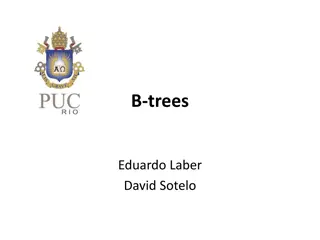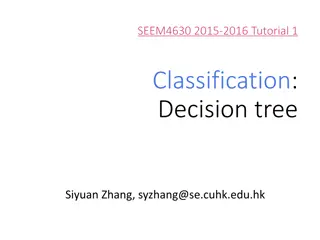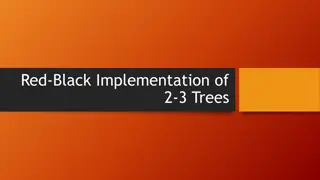Understanding Decision Trees in Classification
Decision trees are a popular machine learning algorithm for classification tasks. They consist of nodes representing conditions, branches indicating decisions, and leaves representing outcomes. By choosing the best attribute and splitting data recursively, decision trees can efficiently classify data. The selection of the best attribute relies on factors such as information gain and Gini index. Understanding the concepts of entropy, information gain, and node purity is crucial in building accurate decision trees.
Uploaded on Nov 26, 2024 | 0 Views
Download Presentation

Please find below an Image/Link to download the presentation.
The content on the website is provided AS IS for your information and personal use only. It may not be sold, licensed, or shared on other websites without obtaining consent from the author. Download presentation by click this link. If you encounter any issues during the download, it is possible that the publisher has removed the file from their server.
E N D
Presentation Transcript
Classification Decision trees
What is a decision tree? "First" node is the root of the tree "Last" nodes are called leaves The edges between nodes represent branches How do we "read" a decision tree?
How to "build" a decision tree? Procedure (recursive): Choose the "best" attribute Split the data into subsets according to the values of the "best" attribute Repeat the procedure in each of the subsets Stop when (the stopping criterion): out of attributes, all leaves are "pure" (all examples in a leaf belong to the same class), the (sub)set is empty.
Choosing the "best" attribute Which attribute is "the best"? The one, yielding the smaller tree The one, yielding the highest classification accuracy Heuristic: choose attribute, yielding "purest" nodes Let's look at some "(im)purity" measures: Information gain Information gain ration Gini index
Information gain Measuring the information as entropy: given the probability distribution of some events, entropy measures the information that is needed to encode every possible outcome of these events entropy is measured in bits Formula for computing the entropy: entropy ?1,?2,...,?? = ?1log2?1 ?2log2?2 ... ??log2?? where p1, p2, , pn are the probabilities of given events
Computing information "before" If a set T contains examples with n classes, info(T) is defined as: where pj is the relative frequency (probability) of class j in T.
Computing information "after" We split the set T containing N examples into subsets T1, T2, , Tk containing N1, N2, , Nk examples, respectively. The information of this split is defined as: ?? ?????(??) ? = ?=1 ?????????(?) = ???? ?1,?2, ,??
Information gain definition ???????? ? = ???? ? ???? ??,??, ,?? Information gain = = information "before split" information "after split" InfoGain = IBS IAS
InfoGain the "weather" example Outlook Temperature Humidity Windy Play Sunny Hot High False No Sunny Hot High True No Overcast Hot High False Yes Rainy Mild High False Yes Rainy Cool Normal False Yes Rainy Cool Normal True No Overcast Cool Normal True Yes Sunny Mild High False No Sunny Cool Normal False Yes Rainy Mild Normal False Yes Sunny Mild Normal True Yes Overcast Mild High True Yes Overcast Hot Normal False Yes Rainy Mild High True No
Computing the IBS Information "before the split": Yes: 9 examples No: 5 examples Info([9,5]) = entropy(5/14, 9/14) = = 5/14 * log2(5/14) 9/14 * log2(9/14) = 0.940
InfoGain("outlook") Entropy (bits) Outlook Yes No P(Yes) P(No) Probability Sunny 2 3 2/5 3/5 0.971 5/14 Overcast 4 0 4/4 0/4 0 4/14 Rainy 3 2 3/5 2/5 0.971 5/14 Entropy: Sunny: Info([2,3]) = entropy(2/5,3/5) = 2/5 * log2(2/5) 3/5 * log2(3/5) = 0.971 Overcast: Info([4,0]) = entropy(1,0) = 1 * log2(1) 0 * log2(0) = 0 Rainy: Info([3,2]) = entropy(3/5,2/5) = 3/5 * log2(3/5) 2/5 * log2(2/5) = 0.971 Info("outlook")= Info([2,3],[4,0],[3,2]) = (5/14) * 0.971 + (4/14) * 0 + (5/14) * 0.971 = 0.693 InfoGain("outlook") = IBS Info("outlook") InfoGain("outlook") = 0.940 0.693 = 0.247 0.247
InfoGain("temperature") Entropy (bits) Temperature Yes No P(Yes) P(No) Probability Hot 2 2 2/4 2/4 1 4/14 Mild 4 2 4/6 2/6 0.918 6/14 Cool 3 1 3/4 1/4 0.811 4/14 Entropy: Hot: Info([2,2]) = entropy(2/4,2/4) = 2/4 * log2(2/4) 2/4 * log2(2/4) = 1 Mild: Info([4,2]) = entropy(4/6,2/6) = 4/6 * log2(4/6) 2/6 * log2(2/6) = 0.918 Cool: Info([3,1]) = entropy(3/4,1/4) = 3/4 * log2(3/4) 1/4 * log2(1/4) = 0.811 Info("temperature") = Info([2,2],[4,2],[3,1]) = (4/14) * 1 + (6/14) * 0.918 + (4/14) * 0.811 = 0.911 InfoGain("temperature") = 0.940 0.911 = 0.029 0.029
InfoGain("humidity") Entropy (bits) Humidity Yes No P(Yes) P(No) Probability High 3 4 3/7 4/7 0.985 7/14 Normal 6 1 6/7 1/7 0.592 7/14 Entropy: High: Info([3,4]) = entropy(3/7,4/7) = 3/7 * log2(3/7) 4/7 * log2(4/7) = 0.985 Normal: Info([6,1]) = entropy(6/7,1/7) = 6/7 * log2(6/7) 1/7 * log2(1/7) = 0.592 Info("humidity") = Info([3,4],[6,1]) = (7/14) * 0.985 + (7/14) * 0.592 = 0.789 InfoGain("humidity") = 0.940 0.789 = 0.151 0.151
InfoGain("windy") Entropy (bits) Windy Yes No P(Yes) P(No) Probability True 6 2 6/8 2/8 8/14 0.811 False 3 3 3/6 3/6 6/14 1 Entropy: True: Info([6,2]) = entropy(6/8,2/8) = 6/8 * log2(6/8) 2/8 * log2(2/8) = 0.811 False: Info([3,3]) = entropy(3/6,3/6) = 3/6 * log2(3/6) 3/6 * log2(3/6) = 1 Info("windy") = Info([6,2],[3,3]) = (8/14) * 0.811 + (6/14) * 1 = 0.892 InfoGain("windy") = 0.940 0.892 = 0.048 0.048
Which attribute is "best"? The one with the highest information gain (InfoGain): Outlook: 0.247 bits Temperature: 0.029 bits Humidity: 0.152 bits Wind: 0.048 bits
Step 2 = recursion Outlook = Sunny Outlook Temperature Humidity Windy Play Sunny Hot High False No Sunny Hot High True No Overcast Hot High False Yes Rainy Mild High False Yes Rainy Cool Normal False Yes Rainy Cool Normal True No Overcast Cool Normal True Yes Sunny Mild High False No Sunny Cool Normal False Yes Rainy Mild Normal False Yes Sunny Mild Normal True Yes Overcast Mild High True Yes Overcast Hot Normal False Yes Rainy Mild High True No
Next level in the tree Outlook = Sunny Attribute Temperature Outlook Temperature Humidity Windy Play Sunny Hot High False No Sunny Hot High True No Sunny Mild High False No Sunny Cool Normal False Yes Sunny Mild Normal True Yes Entropy (bits) Temperature Yes No P(Yes) P(No) Probability Hot 0 2 0/2 2/2 0 2/5 Hot: info([0,2]) = entropy(0,1) = 0 Mild: info([1,1]) = entropy(1/2,1/2) = 1 Cool: info([1,0]) = entropy(1,0) = 0 Mild 1 1 1/2 1/2 1 2/5 Cool 1 0 1/1 0/1 0 1/5 Info("Temperature") = info([0,2],[1,1,],[1,0]) = 2/5*0 + 2/5*1 + 1/5*0 = 0.4 InfoGain("Temperature") = info([2,3]) info([0,2],[1,1,],[1,0]) = 0.971 0.4 = 0.571 0.571
Next level in the tree Outlook = Sunny Attribute Humidity Outlook Temperature Humidity Windy Play Sunny Hot High False No Sunny Hot High True No Sunny Mild High False No Sunny Cool Normal False Yes Sunny Mild Normal True Yes Entropy (bits) Humidity Yes No P(Yes) P(No) Probability High 0 3 0/3 3/3 0 3/5 High: info([0,3]) = entropy(0,1) = 0 Normal: info([2,0]) = entropy(1,0) = 0 Normal 2 0 2/2 0/2 0 2/5 Info("Humidity") = info([0,3],[2,0]) = 2/5*0 + 3/5*0 = 0 InfoGain("Humidity") = info([2,3]) info([0,3],[2,0]) = 0.971 0 = 0.971 0.971
Next level in the tree Outlook = Sunny Attribute Windy Outlook Temp Humidity Windy Play Sunny Hot High False No Sunny Hot High True No Sunny Mild High False No Sunny Cool Normal False Yes Sunny Mild Normal True Yes Entropy (bits) Windy Yes No P(Yes) P(No) Probability True 1 2 1/3 2/3 0.918 3/5 False 1 1 1/2 1/2 1 2/5 True: info([1,2]) = entropy(1/3,2/3) = 1/3*log2(1/3) 2/3*log2(2/3) = 0.918 False: info([1,1]) = entropy(1/2,1/2) = 1/2*log2(1/2) 1/2*log2(1/2) = 1 Info("Windy") = info([1,2],[1,1]) = 3/5* 0.918 + 2/5*1 = 0.951 InfoGain("Windy") = info([2,3]) info([1,2],[1,1,]) = 0.971 0.951 = 0.02 0.02
Choosing the "best" attribute Information gain (InfoGain): Temperature: 0.571 Humidity: Windy: Choose the attribute Humidity The leaves are pure no need to continue the procedure 0.971 0.02
Step 2 = recursion Outlook = Overcast Outlook Temp Humidity Windy Play Sunny Hot High False No Sunny Hot High True No Overcast Hot High False Yes Rainy Mild High False Yes Rainy Cool Normal False Yes Rainy Cool Normal True No Overcast Cool Normal True Yes Sunny Mild High False No Sunny Cool Normal False Yes Rainy Mild Normal False Yes Sunny Mild Normal True Yes Overcast Mild High True Yes Overcast Hot Normal False Yes Rainy Mild High True No
Next level in the tree Outlook = Overcast Temp Humidity Outlook Windy Play Overcast Hot High False Yes Overcast Cool Normal True Yes Overcast Mild High True Yes Overcast Hot Normal False Yes No need to further split the node is "pure" (contains just examples of class "Yes")
Step 2 = recursion Outlook = Rainy Outlook Temp Humidity Windy Play Sunny Hot High False No Sunny Hot High True No Overcast Hot High False Yes Rainy Mild High False Yes Rainy Cool Normal False Yes Rainy Cool Normal True No Overcast Cool Normal True Yes Sunny Mild High False No Sunny Cool Normal False Yes Rainy Mild Normal False Yes Sunny Mild Normal True Yes Overcast Mild High True Yes Overcast Hot Normal False Yes Rainy Mild High True No
Next level in the tree Outlook = Rainy Outlook Temperature Humidity Windy Play Rainy Mild High False Yes Rainy Cool Normal False Yes Rainy Cool Normal True No Rainy Mild Normal False Yes Rainy Mild High True No Entropy (bits) Temperature Yes No P(Yes) P(No) Probability Mild 2 1 2/3 1/3 0.918 3/5 Cool 1 1 1/2 1/2 1 2/5 Mild: info([1,2]) = entropy(1/3,2/3) = 1/3*log2(1/3) 2/3*log2(2/3) = 0.918 Cool: info([1,1]) = entropy(1/2,1/2) = 1/2*log2(1/2) 1/2*log2(1/2) = 1 Info("Temperature") = info([2,1],[1,1]) = 3/5*0.918 + 2/5*1 = 0.951 InfoGain("Temperature") = info([2,3]) info([1,2],[1,1,]) = 0.971 0.951 = 0.02 0.02
Next level in the tree Outlook = Rainy Outlook Temp Humidity Windy Play Rainy Mild High False Yes Rainy Cool Normal False Yes Rainy Cool Normal True No Rainy Mild Normal False Yes Rainy Mild High True No Entropy (bits) Humidity Yes No P(Yes) P(No) Probability High 1 1 1/2 1/2 1 2/5 Normal 2 1 2/3 1/3 0.918 3/5 High: info([1,1]) = entropy(1/2,1/2) = 1/2*log2(1/2) 1/2*log2(1/2) = 1 Normal: info([1,2]) = entropy(1/3,2/3) = 1/3*log2(1/3) 2/3*log2(2/3) = 0.918 Info("Humidity") = info([2,1],[1,1]) = 3/5*0.918 + 2/5*1 = 0.951 InfoGain("Humidity") = info([2,3]) info([1,2],[1,1,]) = 0.971 0.951 = 0.02 0.02
Next level in the tree Outlook = Rainy Outlook Temp Humidity Windy Play Rainy Mild High False Yes Rainy Cool Normal False Yes Rainy Cool Normal True No Rainy Mild Normal False Yes Rainy Mild High True No Entropy (bits) Windy Yes No P(Yes) P(No) Probability True 0 2 0/2 2/2 0 2/5 High: info([0,2]) = 0 Normal: info([3,0]) = 0 False 3 0 3/3 0/3 0 3/5 Info ("Windy") = info([2,1],[1,1]) = 3/5*0 + 2/5*0 = 0 InfoGain("Windy") = info([2,3]) info([1,2],[1,1,]) = 0.971 0 = 0.971 0.971
Choosing the "best" attribute Informatiom gain (InfoGain): Temperature: 0.02 Humidity: Windy: Choose the attribute Windy The leaves are pure no need to continue the procedure 0.02 0.971
Information gain: problems If an attribute has many values, there is a higher probability that the subsets will be "pure"; Consequence InfoGain "perfers" attributes with larger number of values.
Example: attribute "ID code" The entropy of the split = 0 (each leaf is "pure" containing just a single example); Information gain of attribute "ID code" is maximal = extreme case
Information gain ratio (GainRatio) Intrinsic/split information = entropy of the split ????????????? ?,? = |??| |??| |?|. |?|log2 Information gain ratio (GainRatio): ????????(?,?) ?????????????(?,?). ?????????(?,?) =
GainRatio("outlook") Entropy (bits) Outlook Yes No P(Yes) P(No) Probability Sunny 2 3 2/5 3/5 0.971 5/14 Overcast 4 0 4/4 0/4 0 4/14 Rainy 3 2 3/5 2/5 0.971 5/14 InfoGain("outlook") = 0.940 0.693 = 0.247 SplitInfo("outlook") = info([5,4,5]) = entropy(5/14, 4/14, 5/14) = = 5/14*log2(5/14) 4/14*log2(4/14) 5/14*log2(5/14) = 1.577 GainRatio("outlook") = InfoGain("outlook") / SplitInfo("outlook") = = 0.247 / 1.577 =0.156 0.156
GainRatio("temperature") Entropy (bits) Temperature Yes No P(Yes) P(No) Probability Hot 2 2 2/4 2/4 1 4/14 Mild 4 2 4/6 2/6 0.918 6/14 Cool 3 1 3/4 1/4 0.811 4/14 InfoGain("temperature") = 0.940 0.911 = 0.029 SplitInfo("temperature") = info([4,6,4]) = entropy(4/14, 6/14, 4/14) = = 4/14*log2(4/14) 6/14*log2(6/14) 4/14*log2(4/14) = 1.362 GainRatio("temperature") = InfoGain("temperature") / SplitInfo("temperature") = = 0.029 / 1.362 = 0.021 0.021
GainRatio("humidity") Entropy (bits) Humidity Yes No P(Yes) P(No) Probability Hot 3 4 3/7 4/7 0.985 7/14 Mild 6 1 6/7 1/7 0.592 7/14 InfoGain("humidity") = 0.940 0.789 = 0.151 SplitInfo("humidity") = info([7,7]) = entropy(7/14, 7/14) = = 7/14*log2(7/14) 7/14*log2(7/14) = 1 GainRatio("humidity") = InfoGain("humidity") / SplitInfo("humidity") = = 0.151 / 1 = 0.151 0.151
GainRatio("windy") Entropy (bits) Windy Yes No P(Yes) P(No) Probability True 6 2 6/8 2/8 0.811 8/14 False 3 3 3/3 3/3 1 6/14 InfoGain("windy") = 0.940 0.892 = 0.048 SplitInfo("windy") = info([8,6]) = entropy(8/14, 6/14) = = 8/14*log2(8/14) 6/14*log2(6/14) = 0.985 GainRatio("windy") = InfoGain("windy") / SplitInfo("windy") = = 0.048 / 0.985 = 0.049 0.049
Choosing the "best" attribute Information gain ratio (GainRatio): Outlook: 0.156 bits Temperature: 0.021 bits Humidity: 0.152 bits Windy: 0.049 bits
Gini index "before split" If a set T contains examples with n classes, gini(T) is defined as: ? ??2 ???? ? = 1 ?=1 where pj is the relative frequency (probability) of class j in T.
Gini index "after split" We split the set T containing N examples into subsets T1, T2, , Tk containing N1, N2, , Nk examples, respectively. The information of this split is defined as: ? ?? ?????(??) ?????????(?) = ?=1 The attribute with the lowest ginisplit(T) is chosen as the "best" attribute.
Gini("outlook") Outlook Yes No P(Yes) P(No) Gini Probability Sunny 2 3 2/5 3/5 0.48 5/14 Overcast 4 0 4/4 0/4 0 4/14 Rainy 3 2 3/5 2/5 5/14 0.48 Gini index: Sunny: Gini([2/5,3/5]) = 1 ((2/5)2 + (3/5)2) = 0.48 Overcast: Gini([4/4,0/4]) = 1 ((4/4)2 + (0/4)2) = 0 Rainy: Gini([3/5,2/5]) = 1 ((3/5)2 + (2/5)2) = 0.48 Gini("outlook") = (5/14)*0.48 + (4/14)*0 + (5/14)*0.48 = 0.342 0.342
Gini("temperature") Temperature Yes No P(Yes) P(No) Gini Probability Hot 2 2 2/4 2/4 0.5 4/14 Mild 4 2 4/6 2/6 0.444 6/14 Cool 3 1 3/4 1/4 0.375 4/14 Gini index: Hot: Gini(2/4,2/4) = 1 ((2/4)2 + (2/4)2) = 0.5 Mild: Gini(4/6,2/6) = 1 ((4/6)2 + (2/6)2) = 0.444 Cool: Gini(3/4,1/4) = 1 ((3/4)2 + (1/4)2) = 0.375 Gini("temperature") = (4/14)*0.5 + (6/14)*0.444 + (4/14)*0.375 = 0.440 0.440
Gini("humidity") Humidity Yes No P(Yes) P(No) Gini Probability High 3 4 3/7 4/7 0.490 7/14 Normal 6 1 6/7 1/7 0.245 7/14 Gini index: High: Gini(3/7,4/7) = 1 ((3/7)2 + (4/7)2) = 0.490 Normal: Gini(6/7,1/7) = 1 ((6/7)2 + (1/7)2) = 0.245 Gini("humidity") = (7/14)*0.490 + (7/14)*0.245 = 0.368 0.368
Gini("windy") Windy Yes No P(Yes) P(No) Gini Probability True 6 2 6/8 3/8 0.375 8/14 False 3 3 3/3 3/3 0.5 6/14 Gini index: True: Gini(6/8,2/8) = 1 ((6/8)2 + (2/8)2) = 0.375 False: Gini(3/6,3/6) = 1 ((3/6)2 + (3/6)2) = 0.5 Gini("windy") = (8/14)*0.375 + (6/14)*0.5 = 0.429 0.429
Choosing the "best" attribute Gini index: Outlook: Temperature: 0.440 Humidity: Windy: 0.342 0.368 0.429
How to classify new examples? Outlook Temperature Humidity Windy Play Overcast Hot High False Yes Sunny Cool High True No Rainy Mild High False Yes
And for slightly different data? I D A 5 3 5 1 5 3 5 3 2 4 2 B E 14 32 12 21 20 3 4 2 16 20 13 F C y z y y y w w x y z z 438 12.03.2040 450 24.04.1934 461 05.01.1989 466 07.08.1945 467 21.07.2028 469 30.04.1966 485 28.02.2015 514 19.03.2033 522 13.03.2022 529 28.07.2037 534 05.10.1986 3.49 58.48 47.23 31.40 79.60 19.88 59.13 27.05 80.14 65.02 99.17 good bad bad good bad bad bad bad good bad good
InfoGain("A") A 1 2 3 4 5 w 0 0 1 0 1 x 0 0 1 0 0 y 1 1 0 0 3 z 0 1 1 1 0 P(w) 0/1 0/2 1/3 0/1 1/4 P(x) 0/1 0/2 1/3 0/1 0/4 P(y) 1/1 1/2 0/3 0/1 3/4 P(z) 0/1 1/2 1/3 1/1 0/4 entropy probabilities 0 1 1.585 0 0.811 1/11 2/11 3/11 1/11 4/11 IBS = info([2,1,5,3]) = entropy(2/11,1/11,5/11,3/11) = = 2/11*log2(2/11) 1/11*log2(1/11) 5/11*log2(5/11) 3/11*log2(3/11) = 1.79 1: info([0,0,1,0]) = entropy(0,0,1,0) = 3*0/1*log2(0/1) 1/1*log2(1/1) = 0 2: info([0,0,1,1]) = entropy(0,0,1/2,1/2) = 2*0/2*log2(0/2) 2*1/2*log2(1/2) = 1 3: info([1,1,0,1]) = entropy(1/3,1/3,0,1/3) = 0/3*log2(0/3) 3*1/3*log2(1/3) = 1.585 4: info([0,0,0,1]) = entropy(0,0,0,1) = 3*0/1*log2(0/1) 1/1*log2(1/1) = 0 5: info([1,0,3,0]) = entropy(1/4,0,3/4,0) = 2*0/4*log2(0/4) 1/4*log2(1/4) 3/4*log2(3/4) = 0.811 Info("A") = 1/11*0 + 2/11*1 + 3/11*1.585 + 1/11*0 + 4/11*0.811 = 0.909 The "rest" for homework InfoGain("A") = 1.79 0.909 = 0.881 0.881























